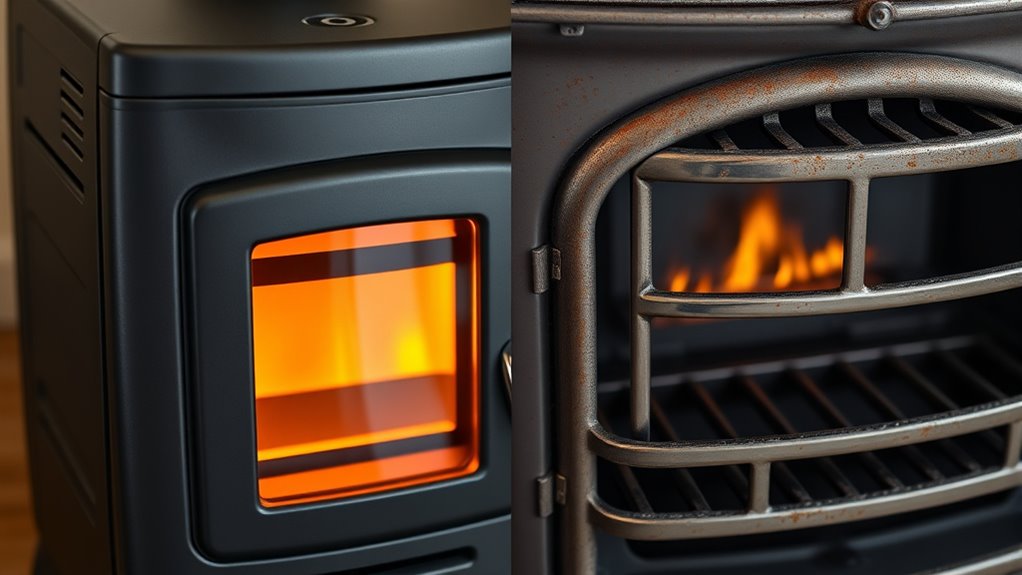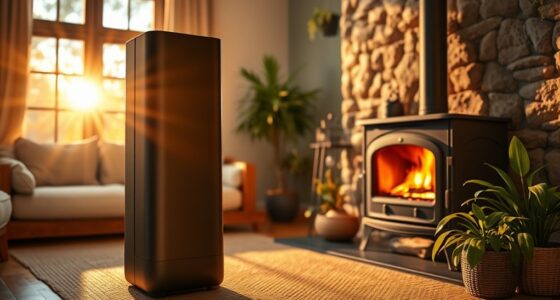Catalytic and non-catalytic stoves meet emissions standards through different methods. Catalytic models use a special catalyst to reduce pollutants at lower temperatures, but need regular inspection and replacement. Non-catalytic stoves burn fuel at higher temps with advanced design features to meet regulations. Maintenance needs vary, with catalytic stoves often requiring more upkeep. Exploring these differences helps you choose the right stove to stay compliant—there’s more to learn about how each type handles regulation requirements.
Key Takeaways
- Catalytic stoves meet emission standards primarily through a catalytic process that reduces pollutants at lower temperatures.
- Non-catalytic stoves comply via high-temperature combustion and advanced design features without needing a catalyst.
- Catalytic models require regular catalyst inspections and replacements to maintain regulatory compliance.
- Non-catalytic stoves generally have simpler maintenance, focusing on cleaning and proper operation to meet standards.
- Both types must adhere to local emission regulations, but their pathways to compliance differ based on design and maintenance requirements.

When choosing a stove, understanding the difference between catalytic and non-catalytic models can help you make an informed decision. One key aspect to take into account is how each type meets emission standards and what maintenance they require. Catalytic stoves use a special catalyst, typically made of ceramic or metal, to facilitate combustion at lower temperatures. This process results in cleaner burning and reduced emissions, making them more effective at complying with strict emission standards. However, because they rely on a catalyst, these stoves often have more complex maintenance needs. The catalyst can become clogged or damaged over time, requiring regular inspections and occasional replacement to maintain ideal performance. This means you’ll need to be prepared for periodic upkeep, which can add to the overall cost and effort of owning a catalytic stove. Proper operation and regular cleaning are essential for both stove types to meet regulatory requirements and ensure optimal performance. In contrast, non-catalytic stoves operate without the need for a catalyst, using high-temperature combustion to burn wood or other fuels more efficiently. They are generally simpler in design, which translates to easier maintenance. These models tend to have fewer components that can fail or require replacement, making them more straightforward to service. Because they burn fuel at higher temperatures, non-catalytic stoves often produce higher emissions initially, but advancements in design have helped them meet newer emission standards with proper operation and regular cleaning. Their simpler construction also means you don’t need to worry about replacing catalysts periodically, which can be a significant advantage if you prefer a low-maintenance option. From a regulatory standpoint, both stove types must adhere to emission standards set by local authorities, but the pathways to compliance differ. Catalytic models typically meet these standards through their cleaner combustion process, which reduces particulate matter and other pollutants. Non-catalytic stoves, on the other hand, rely on advanced combustion techniques and design features to achieve similar emissions levels. These differences influence not only how each stove is built but also the level of ongoing maintenance required to stay within regulatory limits. If you’re looking for a model with minimal maintenance, a non-catalytic stove might be appealing, but if you prioritize lower emissions and are prepared for periodic catalyst care, a catalytic stove could be the better choice. Ensuring proper stove maintenance is crucial for meeting emission standards and prolonging the lifespan of your stove.
Frequently Asked Questions
How Do Catalytic Stoves Impact Indoor Air Quality?
You might find that catalytic stoves can improve indoor air quality by reducing emissions and controlling indoor air pollution. Their catalytic converters burn off harmful gases more efficiently, releasing fewer pollutants into your home. This means you breathe cleaner air and reduce health risks associated with indoor air pollution. However, regular maintenance is essential to guarantee the emissions control system works properly, keeping your indoor environment safer and healthier.
Are Non-Catalytic Stoves More Energy-Efficient Than Catalytic Ones?
Sure, non-catalytic stoves often seem more energy-efficient at first glance, but don’t be fooled—they’re just cheaper to buy. The efficiency comparison shows they burn fuel faster, but that means more frequent refueling and higher long-term costs. You might save upfront, but consider the ongoing expense and maintenance. So, if you’re after true efficiency, weigh the initial cost against the long-term savings—non-catalytic isn’t always the winner.
What Maintenance Is Required for Catalytic Versus Non-Catalytic Stoves?
You need to clean your catalytic stove’s catalytic converter regularly, about once a year, to sustain efficiency, and replace parts like the converter if it becomes damaged. For non-catalytic stoves, cleaning the interior and chimney every few months is essential to prevent creosote buildup and ensure safe operation. Both types require periodic inspection, but catalytic stoves demand more specific part replacements to keep them working properly.
Do Regulatory Standards Differ by Country for These Stove Types?
You’ll find that regulatory standards wildly vary across countries for these stove types, making international compliance feel like steering a maze! Regional regulations dictate specific emissions limits, safety features, and maintenance requirements, so what’s legal in one country might not be in another. You must stay informed about local laws to guarantee your stove meets all regional standards, avoiding costly fines or safety issues down the road.
Can Catalytic Stoves Operate Effectively With Alternative Fuels?
Yes, catalytic stoves can operate effectively with alternative fuels, but their efficiency depends on the fuel type. You should consider the stove’s compatibility with specific fuels when comparing efficiency and safety. Conduct a stove efficiency comparison to guarantee maximum performance. Using alternative fuels may require adjustments or special catalysts to maintain efficiency and emissions standards, so always check manufacturer guidelines before switching fuels.
Conclusion
Ultimately, choosing between catalytic and non-catalytic stoves is like selecting a dance partner—each has its rhythm and charm. Catalytic stoves offer a graceful, eco-friendly waltz, while non-catalytic ones perform a lively, straightforward jig. Understanding their regulatory differences helps you choreograph your home’s warmth with confidence. Whichever you pick, make sure it aligns with your environmental values and lifestyle, turning your space into a cozy stage where comfort and responsibility dance in harmony.











